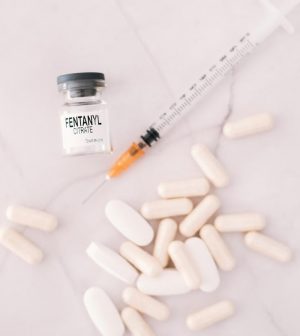- Understanding the Connection Between Anxiety and Depression
- How Daily Prunes Can Influence Cholesterol and Inflammation
- When to Take B12 for Better Absorption and Energy
- Epsom Salts: Health Benefits and Uses
- See What Saffron Can Do for Sleep and Heart Health
- 6 Common Mistakes to Avoid Before Your Physical
- Can Sweating Really Help You Beat a Cold?
- Strengthening Your Relationship: Practical Strategies
- Skip Storing This Everyday Product in the Fridge Door
- Green Tea + B3 Pairing May Boost Brain Health
U.S. Overdose Deaths Fell 17% in Just One Year

In news that suggest the U.S. opioid epidemic may be easing, drug overdose deaths fell 17% between July 2023 and July 2024.
Per new data released Wednesday by the U.S. Centers for Disease Control and Prevention, about 94,000 people died from drug overdoses (ODs) during that 12-month period, down from more than 113,000 deaths between July 2022 and July 2023.
The data represents “the largest recorded reduction in overdose deaths, ever, and this is no coincidence,” Neera Tanden, director of the White House Domestic Policy Council, told STAT.
Efforts to distribute the OD reversal drug naloxone account for much of this decline, White House officials said.
As many as 500,000 overdoses have been reversed in the United States, thanks to the medication, they added.
Naloxone is now available over-the-counter, and is often handed out with prescriptions for opioid painkillers.
“A soldier or a trauma doc will tell you the very first thing you need to do is to [stop] the bleeding,” Dr. Rahul Gupta, from the White House Office of National Drug Control Police, told CBS News. “If you don’t do that, nothing else matters. We cannot treat dead people.”
Policies to make addiction treatment more accessible also contributed to the decline in overdose deaths, as well as strategies to help drug users protect themselves like test strips to detect fentanyl added to illicit narcotics, White House officials said.
The White House also credited efforts to crack down on drug production, including cooperation with China to halt the flow of precursor chemicals used to make fentanyl.
“For far too many years, drug traffickers counted their money while we counted our debt. And we needed to turn that around. We needed to understand that this is a global business, and we need to treat it like one,” Gupta said.
Opioids continue to account for most drug ODs, causing nearly 68,000 deaths between July 2023 and July 2024, CDC estimates show.
North Carolina experienced the greatest reduction in fatal ODs during that 12-month period, with deaths declining nearly 36%.
Other states that saw OD deaths decline the most include Virginia (29%), Ohio (27%), Delaware (25%), Nebraska (24%), Pennsylvania (24%), South Carolina (23%), Wisconsin (23%) and West Virginia (23%).
However, OD deaths continued to increase in some states. Alaska experienced a 40% increase in fatal overdoses, along with Utah (10%), Oregon (5%) and Washington (2%).
“The colossal drop in overdose deaths is undoubtedly cause for optimism, but not necessarily for celebration,” Andrew Kessler, the founder of Slingshot Solutions, a Washington-based consulting firm that specializes in addiction and mental health issues, told STAT.
“The Biden administration has certainly been aggressive in its approach to this issue, yet still even more needs to be done,” he added.
More information
The National Institute on Drug Abuse has more about naloxone.
SOURCE: U.S. Centers for Disease Control and Prevention, data, Dec. 11, 2024; STAT; CBS News
Source: HealthDay
Copyright © 2026 HealthDay. All rights reserved.










